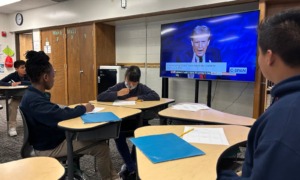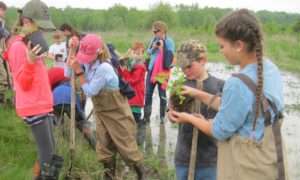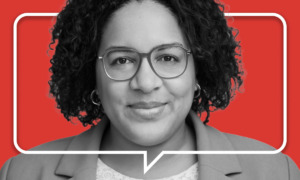New York, N.Y.
(212) 340-2986
http://phoenix.cce.cornell.edu
Objective: Teach youth how to conduct valid community research in order to press for youth priorities in community change – in this case, the rebuilding of lower Manhattan in the wake of the Sept. 11 terrorist attacks.
In a Nutshell: While many view the World Trade Center area as a business district, these youth are pushing for a multicultural/recreational center as part of the space it formerly occupied. Members of the Phoenix Group, made up of students from the area’s High School for Leadership and Public Service (HSLPS), conducted research and engaged in lobbying they hope will persuade urban planners.
Where it Happens: Lower Manhattan, in the vicinity of Ground Zero.
WHEN IT BEGAN: Spring 2002.
Who Started It: The Cornell University Cooperative Extension (CUCE), which among other things develops 4-H programs in New York City. Cornell was already working with students on a cyber-mentoring program when the attack occurred, and it worked with school officials to create a group that would help students feel useful in the face of the tragedy. Five HSLPS students – Yulia Kosiw, Sasha Lebron, Annie Moy, Hillary Saunders and James Wu – got the program off the ground.
Who Runs It: CUCE’s Nina Johnson serves as the program coordinator, helped by retired HSLPS English teacher Ann Gilligan.
Early Obstacles: Because the initial, heavy flow of money to 9/11 matters focused on helping families of victims, it was difficult to secure money for a project that was tangential, says N’Jeri Mitchell, director of CUCE’s Lifelong Learning Program. Another obstacle was “ensuring that groups planning for the rebuilding of downtown would truly hear and incorporate the voices and views of youth,” Mitchell says.
How They Overcame Them: CUCE staff trained youth in how to conduct a broad survey of youth and adults in the area around the school. Through in-person, phone and Internet interviews, 810 students, residents and workers from the area were surveyed.
CUCE taught the youth how to enter the data for analysis and how to produce charts and graphs for presentation. The students’ findings (available at: http://phoenix.cce.cornell.edu/phoenixsurvey2003.html), show that many adults who live or work in the area didn’t even know that Lower Manhattan area is home to two high schools (HLSPS and Bedford Stuyvesant), but they show support from adults and youth for a recreational facility as part of the redevelopment plans.
“They really learned how research works from conception of an idea, through data collection and analysis, to report writing and finally transferring this data into real outcomes,” says Mitchell.
Youth have also communicated with the 92nd Street Y (not affiliated with the YMCA) as a potential partner in the project, which has added credibility to the cause.
Cost: The budget, which started at $50,000 in Phoenix’s first year, has declined each year, to a low of $1,000 for 2004. A $10 per-hour stipend is paid to youth who work with the project during the summer.
Who Pays: Initial outside funding was provided by a grant to Cornell University from the U.S. Department of Agriculture’s Resilient Communities program. This year, the program is relying entirely on support from CUCE.
Who Else Has Kicked In: Mary Ann Castle, director of the local nonprofit Moving Forward, has provided in-kind support to create a database, analyze survey data, prepare a report and publicize efforts.
Youth Served: The only requirement to join the program is a demonstrated interest in civic engagement. The five founders have added six new members to the effort.
Youth Turn-On: Mitchell says the staff has taken great pains to leave the steering of the program in the youths’ hands. “A paid summer internship always helps,” she adds.
Youth Turn-Off: “Like adults, students can become frustrated by the endless bureaucracy involved in community work, particularly in coordinating with different agencies and organizations,” says Mitchell.
What Still Gets in the Way: Transition, a problem faced by many youth-led efforts that include lots of upperclassmen. The first group of youth involved in the program are training a new cadre of youth to keep the cause alive, but six of the original participants will be leaving for college after this summer.




























